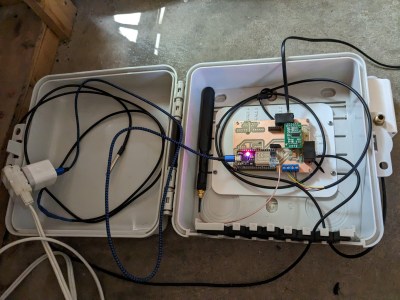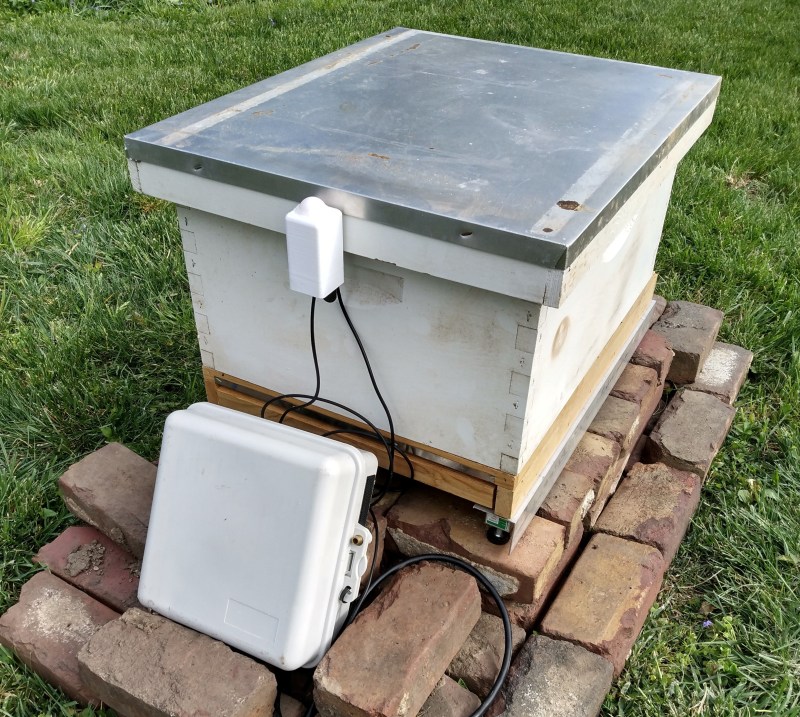Beekeeping is quite the rewarding hobby. There’s delicious honey and useful wax to be had, plus you get the honor of knowing that you’re helping to keep the bee population surviving and thriving. [Ben Brooks] likes to keep tabs on the hive, but doesn’t like the idea of opening it up more often than necessary. After a couple of beekeeping rodeos, [Ben] decided to build his own tracker to get reports on the health and the activity of the hive through Home Assistant.
 This hive tracker features a light sensor, a temperature sensor, and three strain gauges to measure the weight. There would be four, but a mouse decided to take a bite of the wires in the most nightmarish place to repair.
This hive tracker features a light sensor, a temperature sensor, and three strain gauges to measure the weight. There would be four, but a mouse decided to take a bite of the wires in the most nightmarish place to repair.
Everything runs off of an ESP32, and there’s an external antenna involved because the hive is nearly out of Wi-Fi range. The strain gauges are the affordable bathroom-scale type, and [Ben] has extras for if and when the number of hives goes up.
We like the combination of hard work and simplicity going on here — [Ben] milled and drilled the PCB himself, and used phone plugs to connect the temperature and weight sensors. Unfortunately, the plugs make the strain gauges a little finicky, so [Ben] says he would probably use screw terminals next time, or might be soldering the wires sooner rather than later. Consider this one a work in progress, and keep watching for updates as [Ben] works out the kinks.
Interested in beekeeping, but don’t want to build a traditional hive? Check out this beehive in a bottle.

















WiFi near bees? Such a bad idea…
https://ehtrust.org/new-study-wi-fi-frequency-harms-honeybee/
That same study mentions that 50Hz is bad too. That can of worms is never getting closed again.
Crackpot central for people who cannot seem to grasp that you cannot simultaneously tout science and research about EM waves when you like it, and totally ignore it when you don’t.
I doubt you need to send data more often than 1/2 hours apart. So shut off Wifi until data needs to be sent etc. and perhaps, if needed, some alarm values to be sent immediately. Would not bother the little bastards at all.
Although i don’t know if that is easy to do with Home assistant. Would be a good feature to have though. There are lots of sensors that do not need constant Wifi connection, but could gather data offline and send it in patches or just send it the current values periodically.
Can you switch to ethernet instead? Wifi isnt a good idea near a hive.
Running PoE up to 100m over Ethernet to power the remote device, or slightly buried using outdoor, direct burial cable… place in PolyPipe… not tripping over it, or damaging by driving over it… then a nearby lightning strike blows away the Ethernet chips (despite the isolating transformer). Not realistic! WiFi, HaLow, Lora, are the best way forward. If so worried about the effects of an intermittent transmission, mount the radio a couple meters away on a post, thus providing height above bushes, and using inverse square law to significantly reduce power density at the hive. Additionally, a directional panel antenna (10 dBi) or dish (see Ubiquiti, Mikrotik) to focus energy towards the main AP and away from the hive will improve the situation on both matters (reducing hive exposure, and improving the link). Don’t forget to line the hive with tin-foil!
That’s a honey of a project. What? The door’s that way?
Hive half a mind to make a beeline to that door and see to it that you’ll never comb back!
Anything as sensitive as those strain gage sensors needs to be wired up without connectors of any affordable type when outdoors, maybe screwed if the wires are not tinned. Get a soldering gun or at least 100 watt iron if outdoors or doing heaver wiring, a breeze will chill out that little pencil.
Still not sure if it’s 1/4 inch phone jack (very old) or RJ11 Bell Tel telephone jack? Both have splitters that I know of but I wouldn’t use either for sensitive DC stuff even indoors.
Keeping domesticated honeybees to help bees is like keeping chickens to save the California condor.
Interesting project. Recently i also built beehive scales based on LoRa / LoRaWAN.
Advantage of it is, that it basically runs forever and it has a much longer range.
https://www.letscontrolit.com/forum/viewtopic.php?t=10145